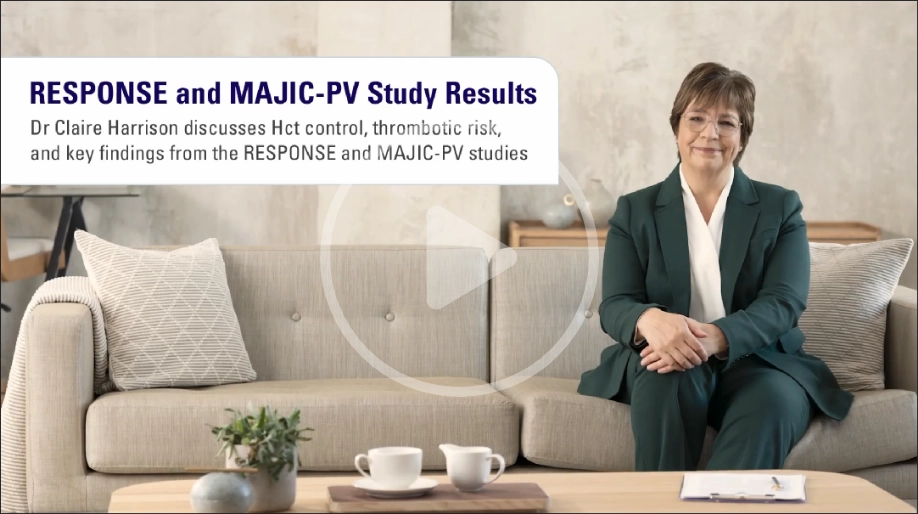(25/110) of patients receiving Jakafi achieved Hct control and ≥35% spleen volume reduction at week 32 vs <1% (1/112) of patients receiving BAT‡ (P<0.0001)1§
For PV in adults who have had an inadequate response to hydroxyurea1
Intervene with Jakafi® (ruxolitinib) to achieve durable count control2

I’d like for my colleagues to understand the importance of identifying patients with PV who have hematocrit levels between 45% and 50%, white blood cell counts above 11, or are needing more than 4 phlebotomies a year. These are the signs that hydroxyurea may be inadequate, and we need to take action immediately by considering a change in treatment plan.
Claire Harrison, DM, FRCPath, MPN Expert
Indication
Jakafi is indicated for treatment of polycythemia vera (PV) in adults who have had an inadequate response to or are intolerant of hydroxyurea.
RESPONSE composite primary endpoint*†
Strict Hct control data
Learn more about Hct control data from the RESPONSE trial
CHR and WBC count data
Review CHR and mean WBC count data from the RESPONSE trial
MAJIC-PV study
Learn more about study results, including data on complete response, event-free survival, and thrombosis-free survival
Safety profile
Review the safety profile from the RESPONSE trial
*The RESPONSE trial was a randomized, open-label, active-controlled phase 3 trial comparing Jakafi with BAT in 222 patients with PV. Patients enrolled in the study had been diagnosed with PV for at least 24 weeks, had an inadequate response to or were intolerant of HU, required phlebotomy for Hct control, and exhibited splenomegaly. All patients were required to demonstrate Hct control between 40% and 45% prior to randomization. After week 32, patients on BAT were able to cross over to Jakafi treatment.1,4
†The composite primary endpoint was defined as Hct control without phlebotomy eligibility and a ≥35% spleen volume reduction as measured by CT or MRI. To achieve the Hct control endpoint, patients could not become eligible for phlebotomy between weeks 8 and 32. Phlebotomy eligibility was defined as Hct >45% that is ≥3 percentage points higher than baseline or Hct >48% (lower value).1,4
‡BAT included HU (60%), interferon/pegylated interferon (12%), anagrelide (7%), pipobroman (2%), lenalidomide/thalidomide (5%), and observation (15%).1
§Jakafi: 95% CI, 0.15-0.32; BAT: 95% CI, 0.00-0.05.1
||Category 1: Based upon high-level evidence, there is uniform NCCN consensus that the intervention is appropriate.3
BAT=best available therapy; CHR=complete hematologic remission; CI=confidence interval; CT=computed tomography; Hct=hematocrit; HU=hydroxyurea; MPN=myeloproliferative neoplasm; MRI=magnetic resonance imaging; NCCN=National Comprehensive Cancer Network® (NCCN®); PV=polycythemia vera; RESPONSE=Randomized study of Efficacy and Safety in POlycythemia vera with JAK iNhibitor ruxolitinib verSus bEst available care; WBC=white blood cell.
References: 1. Jakafi [package insert]. Wilmington, DE: Incyte Corporation. 2. Kiladjian J-J, Zachee P, Hino M, et al. Long-term efficacy and safety of ruxolitinib versus best available therapy in polycythaemia vera (RESPONSE): 5-year follow up of a phase 3 study. Lancet Haematol. 2020;7(3):e226-e237. Supplementary appendix available at: doi:10.1016/S2352-3026(19)30207-8. 3. Referenced with permission from the NCCN Clinical Practice Guidelines in Oncology (NCCN Guidelines®) for Myeloproliferative Neoplasms V.1.2024. © National Comprehensive Cancer Network, Inc. 2023. All rights reserved. Accessed January 4, 2024. To view the most recent and complete version of the guideline, go online to NCCN.org. NCCN makes no warranties of any kind whatsoever regarding their content, use or application and disclaims any responsibility for their application or use in any way. 4. Vannucchi AM, Kiladjian JJ, Griesshammer M, et al. Ruxolitinib versus standard therapy for the treatment of polycythemia vera. N Engl J Med. 2015;372(5):426-435. Supplementary appendix available at: https://www.nejm.org/doi/suppl/10.1056/NEJMoa1409002/suppl_file/nejmoa1409002_appendix.pdf.



